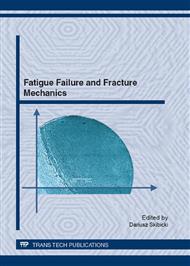[1]
H. K. D. H. Bhadeshia, Steels for Barings, Progress in Materials Science. 57 (2012) 268-435.
Google Scholar
[2]
S. Pytko, M. Szczerek, Pitting – the form of damaging rolling elements, Tribology. 4/5 (1993) 317-334 (in Polish).
Google Scholar
[3]
Z. Gawroński, Technological toplayer in gears and cam mechanisms, Monographies. Lodz University of Technology, 2005 (in Polish).
Google Scholar
[4]
J. Pacyna, Metallurgy of tool steel cracking, Scientific Bulletins, Metallurgy and Foundry Engineering. No. 120, AGH Krakow, 1988 (in Polish).
Google Scholar
[5]
H. Berns, A. Melander, D. Weichert, N. Asnafi, C. Broeckmann, A. GroB-Weege. A new material for cold forging tools, Computational Materials Science. 11 (1998) 166-180.
DOI: 10.1016/s0927-0256(98)00002-0
Google Scholar
[6]
T.Z. Wozniak, K. Rozniatowski, J. Jelenkowski, New Technologies in Heat Treatment of Steel Rolling Bearings 100CrMnSi6-4, Toolmaker (in Polish). 3 (2009) 17-20.
Google Scholar
[7]
T.Z. Wozniak, K. Rozniatowski, Z. Ranachowski, Acoustic Emission in Bearing Steel during Isothermal Formation of Midrib, Metals and Materials International. 17(3) (2011) 365-373.
DOI: 10.1007/s12540-011-0611-4
Google Scholar
[8]
T.Z. Wozniak, K. Rozniatowski, Z. Ranachowski, Application of Acoustic Emission to Monitor Bainitic and Martensitic Transformation, Metallic Materials -Kovove Materialy. 49(5) (2011) 319-331.
DOI: 10.4149/km_2011_5_319
Google Scholar
[9]
C.K. Shui, W.T. Reynolds Jr., G.J. Shiflet, H.I. Aaronson, Etchants for Quantitative Metallography of Bainite and Martensite Microstructures in Fe–C–Mo Alloys, Metallography. 21 (1) (1988) 91-102.
DOI: 10.1016/0026-0800(88)90039-0
Google Scholar
[10]
Report on implementing the Research and Development Project No. R15 010 02 financed by Polish Ministry of Science and Higher Education, System for determinating an optimal austempering temperature by applying the method of acoustic emission. Head of the Project: prof. dr hab. inż. Rożniatowski K. Faculty of Materials Science and Engineering, Warsaw University of Technology, made by: J. Jelenkowski, T. Z. Wozniak (2007-2010), in Polish.
Google Scholar
[11]
T.Z. Wozniak, J. Jelenkowski, K. Rozniatowski, Z. Ranachowski, Station for austempering of steel with the use of acoustic emission, Engineering Quaterly - Metal Treatment, in Polish. 1 (2010) 2-8.
Google Scholar
[12]
T.Z. Wozniak, Z. Ranachowski, Acoustic Emission During Austenite Decomposition into Lower Bainite with Midrib, Archives of Acoustics. 31(3) (2006) 1-15.
Google Scholar
[13]
T.Z. Wozniak, Acoustic Phenomena Near MS in Hypereutectoid Steels, Materials Characterization. 59/6 (2008) 708-716.
DOI: 10.1016/j.matchar.2007.06.004
Google Scholar
[14]
W. Luty, Bearing Steels, WNT, Warszawa, 1969 (in Polish).
Google Scholar
[15]
S. Pytko, Bases of Tribology and Lubricating Engineering, AGH University Course Books (in Polish), No. 1164, 1989.
Google Scholar
[16]
T. Smolnicki, Physical aspects of the coherence of large-size rolling bearings and deformable supporting structures, Monographies 28. Publishing House of the Wroclaw University of Technology, Wroclaw, 2002 (in Polish).
Google Scholar
[17]
F. Akbasoglu, D. Edmonds, Rolling contact fatigue and fatigue crack propagation in 1C-1.5Cr bearing steel in the bainitic condition. Metall. Mater. Trans. A, 21A (1990) 889-893.
DOI: 10.1007/bf02656572
Google Scholar
[18]
S. Pytko, Structures in machine construction and their effect on the devalopment of machinery construction in Poland, Polish and Worldwide Achievements of Science, Gliwice, 2010, p.123–191 (in Polish).
Google Scholar
[19]
M. Hawryluk, M. Zwierzchowski, Structural analysis of dies used for hot forging in the aspect of their reliability, Maintenance and Reliability. 2B (2009) 31-41 (in Polish).
Google Scholar
[20]
L. Mishnaevsky Jr, U. Weber, S. Schmauder, Numerical analysis of the effect of microstructures of particle-reinforced metallic materials on the crack growth and fracture resistance, International Journal of Fracture. 125 (2004) 33-50.
DOI: 10.1023/b:frac.0000021031.67717.9f
Google Scholar
[21]
K. Rozniatowski, Methods of the arrangement inhomogenity characterization of the structural elements in multiphase materials, Scientific Papers of the Warsaw University of Technology. Materials Engineering. 22, 2008 (in Polish).
Google Scholar


